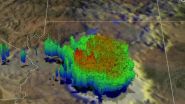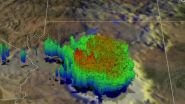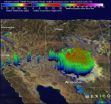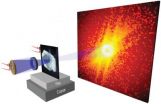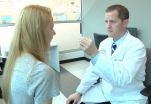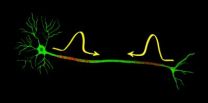(Press-News.org) VIDEO:
This simulated flyby of NASA's TRMM satellite on Sept. 8 saw rain falling at a rate of over 62 mm (2.4 inches) per hour in some downpours over Arizona. Some...
Click here for more information.
Post-tropical storm Norbert may have been centered a couple of hundred miles off the northwestern coast of Mexico's Baja California, but the flow of warm, moist air that spun around it generated drenching thunderstorms over Arizona. NASA's TRMM satellite saw Norbert's remnants and those Arizona thunderstorms dropping rainfall at over 2 inches per hour.
NASA's Tropical Rainfall Measuring Mission or TRMM satellite flew above the post-tropical cyclone remnants of former hurricane Norbert on September 8, 2014 at 0849 UTC (1:49 a.m. PDT). When TRMM passed overhead data gathered from the Microwave Imager (TMI) and Precipitation Radar (PR) instruments showed the rainfall occurring in the low pressure area.
This simulated flyby of NASA's TRMM satellite on Sept. 8 saw rain falling at a rate of over 62 mm (2.4 inches) per hour in some downpours over Arizona. Some thunderstorm tops reached heights of 13.5 km (about 8.4 miles).
Image Credit:
SSAI/NASA, Hal Pierce
TRMM showed only a small amount of light to moderate rainfall was located around Norbert's center of circulation. However, the moisture moving in a huge counterclockwise circulation around Norbert's remnants was transported almost 1,000 miles away where it generated thunderstorms over Arizona. The TRMM image showed very heavy rainfall was being produced over the southwestern United States, including Arizona, southern California and southern Nevada.
Data from TRMM's Precipitation Radar (PR) instrument were used to create a 3-D image at NASA's Goddard Space Flight Center in Greenbelt, Maryland. The 3-D image showed that some showers located to the west of Norbert's center of circulation weren't very high.
The TRMM satellite flew over the southwestern United States again on September 8 at 1205 UTC (5:05 a.m. PDT). At that time a cluster of intense thunderstorms was found in Arizona directly below the satellite. Rain was measured by the TRMM Precipitation Radar (PR) instrument falling at a rate of over 62 mm (2.4 inches) per hour in some downpours.
According to the National Weather Service, 3.29 inches of rain fell at the Phoenix airport breaking the day's record.
For over sixteen years the TRMM's Precipitation Radar (PR) has been providing three dimensional vertical profiles of precipitation from the surface of the earth to heights of about 12 miles (20 kilometers). The 3-D view showed that some thunderstorm tops reached heights of 13.5 km (about 8.4 miles).
On September 8, the moisture spreading northeastward from tropical storm Norbert caused flooding over inland areas of southern California. By September 9, that moisture generated the strong thunderstorms over Arizona that created widespread flooding led the Governor to declare a state of emergency in the state.
INFORMATION:
Hal Pierce
SSAI/NASA's Goddard Space Flight Center
NASA tracks Norbert moisture to Arizona's drenching thunderstorms
2014-09-10
ELSE PRESS RELEASES FROM THIS DATE:
Where to grab space debris
2014-09-10
Objects in space tend to spin — and spin in a way that's totally different from the way they spin on earth. Understanding how objects are spinning, where their centers of mass are, and how their mass is distributed is crucial to any number of actual or potential space missions, from cleaning up debris in the geosynchronous orbit favored by communications satellites to landing a demolition crew on a comet.
In a forthcoming issue of the Journal of Field Robotics, MIT researchers will describe a new algorithm for gauging the rotation of objects in zero gravity using only ...
Advanced light source sets microscopy record
2014-09-10
A record-setting X-ray microscopy experiment may have ushered in a new era for nanoscale imaging. Working at the U.S. Department of Energy (DOE)'s Lawrence Berkeley National Laboratory (Berkeley Lab), a collaboration of researchers used low energy or "soft" X-rays to image structures only five nanometers in size. This resolution, obtained at Berkeley Lab's Advanced Light Source (ALS), a DOE Office of Science User Facility, is the highest ever achieved with X-ray microscopy.
Using ptychography, a coherent diffractive imaging technique based on high-performance scanning ...
Missing piece found to help solve concussion puzzle
2014-09-10
PITTSBURGH, Sept. 10, 2014 – Researchers at UPMC and the University of Pittsburgh have created a new, 5- to 10-minute test that could be added to a clinician's concussion evaluation toolkit for a more comprehensive assessment of the injury.
In a recent study published online first by the American Journal of Sports Medicine, researchers from the UPMC Sports Medicine Concussion Program demonstrated that clinicians could use their novel Vestibular/Ocular Motor Screening (VOMS) examination to be 90 percent accurate in identifying patients with concussion. The VOMS, which ...
Nerve impulses can collide and continue unaffected
2014-09-10
According to the traditional theory of nerves, two nerve impulses sent from opposite ends of a nerve annihilate when they collide. New research from the Niels Bohr Institute now shows that two colliding nerve impulses simply pass through each other and continue unaffected. This supports the theory that nerves function as sound pulses. The results are published in the scientific journal Physical Review X.
Nerve signals control the communication between the billions of cells in an organism and enable them to work together in neural networks. But how do nerve signals work? ...
Non-dominant hand vital to the evolution of the thumb
2014-09-10
New research from biological anthropologists at the University of Kent has shown that the use of the non-dominant hand was likely to have played a vital role in the evolution of modern human hand morphology.
In the largest experiment ever undertaken into the manipulative pressures experienced by the hand during stone tool production, researchers analysed the manipulative forces and frequency of use experienced by the thumb and fingers on the non-dominant hand during a series of stone tool production sequences that replicated early tool forms.
It is well known that ...
Living liver donors ambivalent with donation
2014-09-10
Living donors are important to increasing the number of viable grafts for liver transplantation. A new study published in Liver Transplantation, a journal of the American Association for the Study of Liver Diseases and the International Liver Transplantation Society, found that ambivalence is common among donor candidates. However, providing social support may help minimize the donors' concerns regarding donation.
There is much demand for organs and a shortage of deceased organ donations. One solution to this shortage is the use of living donors for liver transplantation. ...
How skin falls apart: Pathology of autoimmune skin disease is revealed at the nanoscale
2014-09-10
BUFFALO, N.Y. –University at Buffalo researchers and colleagues studying a rare, blistering disease have discovered new details of how autoantibodies destroy healthy cells in skin. This information provides new insights into autoimmune mechanisms in general and could help develop and screen treatments for patients suffering from all autoimmune diseases, estimated to affect 5-10 percent of the U.S. population.
The research, published in PLoS One on Sept. 8, has the potential to help clinicians identify who may be at risk for developing Pemphigus vulgaris (PV), an autoimmune ...
CNIO successfully completes its fisrt clinical trial on HER-2-negative breast cancer with nintedanib
2014-09-10
The experimental drug nintedanib, combined with standard chemotherapy with paclitaxel, causes a total remission of tumours in 50% of patients suffering from early HER-2- negative breast cancer, the most common type of breast cancer. These are the conclusions of the Phase I Clinical Trial, sponsored by the Spanish National Cancer Research Centre (CNIO) and carried out by CNIO ́s Breast Cancer Clinical Research Unit. The study has been published today in British Journal of Cancer, which belongs to Nature Publishing Group.
According to Miguel Ángel Quintela, ...
Monitoring the response of bone metastases to treatment using MRI and PET
2014-09-10
Imaging technologies are very useful in evaluating a patient's response to cancer treatment, and this can be done quite effectively for most tumors using RECIST, Response Evaluation Criteria in Solid Tumors. However, RECIST works well for tumors located in soft tissue, but not so well for cancers that spread to the bone, such as is the case for prostate and breast cancers. More effort, therefore, is needed to improve our understanding of how to monitor the response of bone metastases to treatment using magnetic resonance imaging (MRI) and positron emission tomography (PET), ...
'Electronic skin' could improve early breast cancer detection
2014-09-10
For detecting cancer, manual breast exams seem low-tech compared to other methods such as MRI. But scientists are now developing an "electronic skin" that "feels" and images small lumps that fingers can miss. Knowing the size and shape of a lump could allow for earlier identification of breast cancer, which could save lives. They describe their device, which they've tested on a breast model made of silicone, in the journal ACS Applied Materials & Interfaces.
Ravi F. Saraf and Chieu Van Nguyen point out that early diagnosis of breast cancer, the most common type of cancer ...
